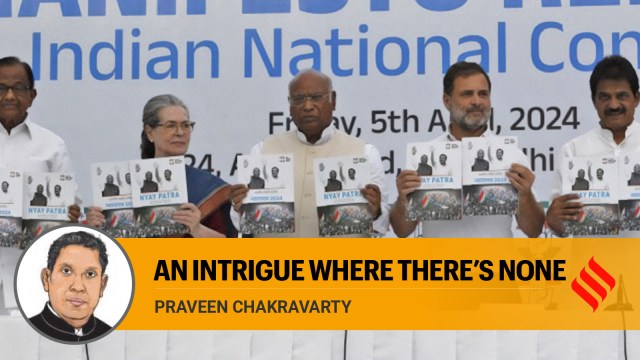
Much like the Shakespearean play Much Ado about Nothing, the Congress party’s manifesto seems to have incited excitement, intrigue, and disbelief with a dash of comedy. But unlike the play’s title, the Congress’s manifesto has “much ado about many things” for a billion Indians.
When the manifesto was launched on April 5 in Delhi, there was excitement over its fresh and bold ideas such as the right to apprenticeship, reversing the damage of the last decade, restoring status quo ante with China, legal guarantee on MSPs for farmers, right to healthcare, doubling India’s share of mining, new law for gig workers and so on. These were genuine policy proposals formulated after extensive consultations with the public, stakeholders and domestic and international domain experts.
On April 6 in Hyderabad, Rahul Gandhi dwelled further on the social justice pillar of the manifesto to outline the Congress’s concern over growing inequities in Indian society along caste lines. He asked why is it that when OBCs, Dalits and tribals constitute roughly 70 per cent of the population, their share in the upper echelons of society, such as senior officers in public sector banks, government bureaucracy and corporate India, is less than 10 per cent. He highlighted the manifesto’s promise that a new Congress government in June will initiate a socio-economic caste census to understand the extent of social and economic disparity. He termed it as the “X ray” of Indian society to better inform us of the gravity and spread of the inequality disease. It is important to note that there is no quibble between the BJP/RSS and the Congress/INDIA blocs about the ugly truth of India’s caste-based inequality. The point of departure is that the former believes it is not in the national interest to reveal these ugly scars while the latter believes it is the logical first step before we can arrive at policy solutions. To be clear, Rahul Gandhi has been articulating the demand for a caste census ever since the first Bharat Jodo Yatra in 2022.
The natural next question is what after the “X ray”? The Congress’s manifesto outlines policy proposals for greater reservation for the oppressed castes and specifies a slew of ideas to increase representation for these caste groups in various fields such as education, business, government contracts, jobs, loans and budgets. It promises to adopt affirmative action policies to redistribute and rebalance the skew in the share of rewards for the oppressed castes. Rahul Gandhi termed this as “jitni abaadi utna haq” (proportional rights), again not for the first time, but it caused enough intrigue. While one can have a legitimate debate on whether these are the right policies to achieve the desired outcome of a fairer society, no one can deny that should be our pursuit. After all, the philosophy behind proportional rights for oppressed castes is no different from the desire for equal representation for women who constitute half the population.
Prime Minister Narendra Modi then added a spin to this saga when he told an unsuspecting crowd in Banswara, Rajasthan that the “Congress party says in its manifesto that it will redistribute wealth by taking away your gold, mangalsutra and assets and giving it to Muslims.” Of course, nowhere in the 48 pages of the party’s manifesto is any such thing mentioned. While Modi may have just blatantly lied, it was a loud enough dog-whistle for the BJP ecosystem to stoke fear, angst and confusion among voters. Soon, a WhatsApp was circulated saying the “Congress party will confiscate two-thirds of the assets of the salaried professionals under the Jawaharlal Nehru National Wealth Redistribution Scheme”. There are reports of cab drivers asking passengers if the Congress indeed plans to take away people’s gold and one newspaper even published an elaborate analysis by some self-styled analyst of this purported “scheme”.
While these insinuations are laughable, they can trigger a toxic combination of communal, class and caste tension lit by a flame of lies. The BJP may harbour a desire to change or even abandon the Constitution, but as things stand today, India is still a constitutional republic under which there is simply no way that a government can enter the homes of people, usurp their gold, land and other assets and give it away to someone else. It is a preposterous assertion but evidently one that Modi can utter without qualms. If any, the only time in the last four decades that there has been an attack on private property of citizens was when Modi took away people’s money overnight through demonetisation. There is not even a semblance of thought in the Congress manifesto or the leadership to seize the private wealth of citizens and redistribute it to others. Admittedly, this pot of confusion was deliberately further stirred by a pliant media using a past-his-prime Congressman’s stray comments endorsing inheritance taxes as a redistribution policy tool. On the contrary, on page 31, the manifesto explicitly promises that neither tax rates nor taxes will increase for people in the five years of a Congress government.
Indian society is plagued by rampant inequality along caste lines. This disease needs to be cured imminently. A caste census is the first step. Greater allocation of government resources for the poor, increased reservation and higher representation of oppressed castes are all forms of “redistribution”. This is what forms the very tenet of a “representative democracy”. Much as we are all agitated about growing inequity, rest assured that neither Rahul Gandhi nor the Congress party has any secret plans to seize your private wealth to solve this. Meanwhile, please read the crisply written 45-page Congress party manifesto for yourself and decide who is bluffing.
The writer is chairman, All India Professionals’ Congress, and a key member of the manifesto committee


